400863 Foundations: Comparing Diet and Exercise in Hypertension
VerifiedAdded on 2023/06/04
|7
|1017
|285
Report
AI Summary
This report assesses the effectiveness of diet versus exercise in the treatment of high blood pressure (hypertension), referencing the GRADE approach for evaluating the quality of evidence. It highlights that while both diet, particularly the DASH diet, and exercise are beneficial, a combination of both is often more effective. The report includes a PICO framework, outlining the population (hypertension patients), intervention (light exercise), comparison (DASH diet vs. normal diet), and outcome (low blood pressure). Studies show a greater reduction in blood pressure when the DASH diet is combined with light exercise compared to either intervention alone. The conclusion emphasizes the importance of combining DASH diet with light exercises for obese individuals with hypertension to achieve significant improvements in blood pressure and vascular health. Desklib provides a platform to access this and similar solved assignments.
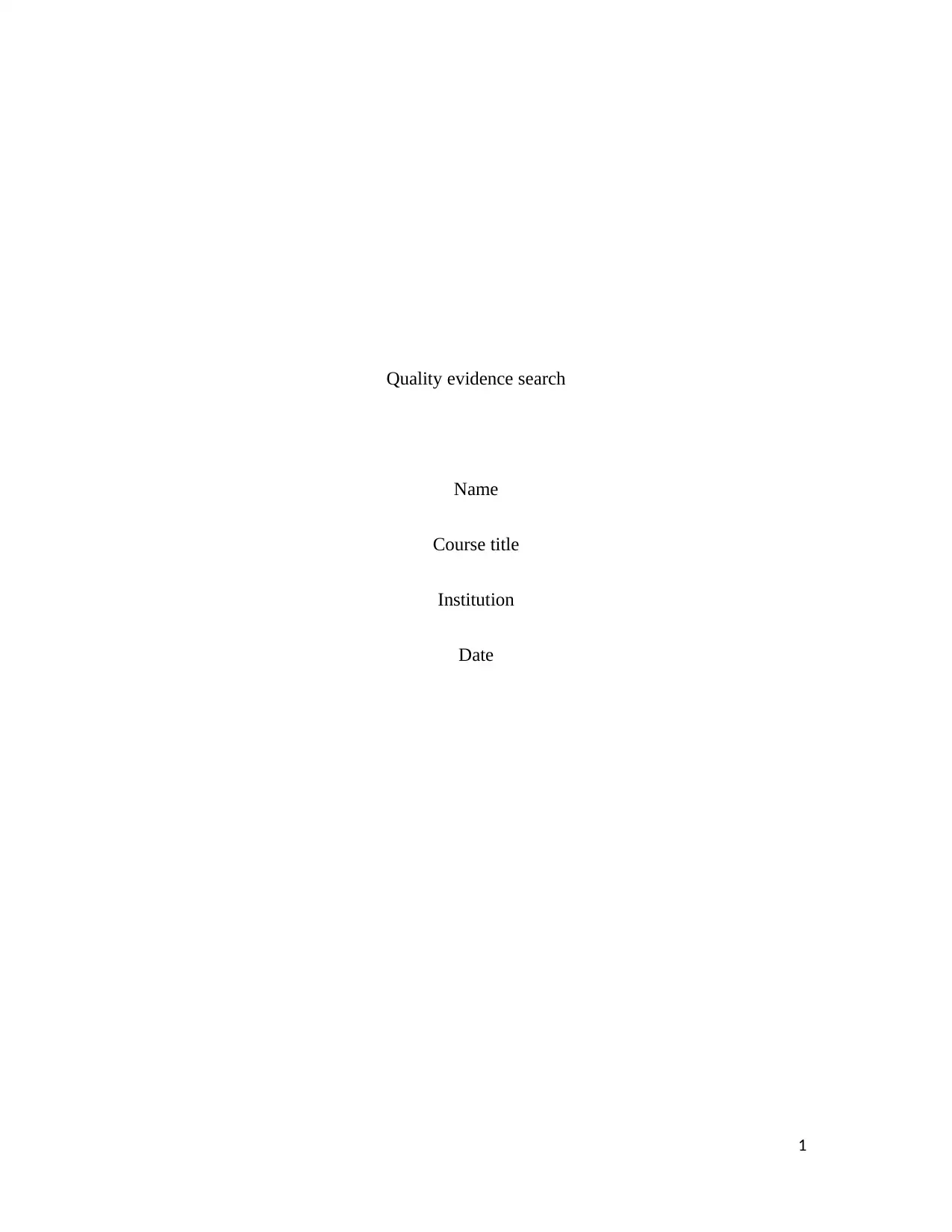
Quality evidence search
Name
Course title
Institution
Date
1
Name
Course title
Institution
Date
1
Paraphrase This Document
Need a fresh take? Get an instant paraphrase of this document with our AI Paraphraser
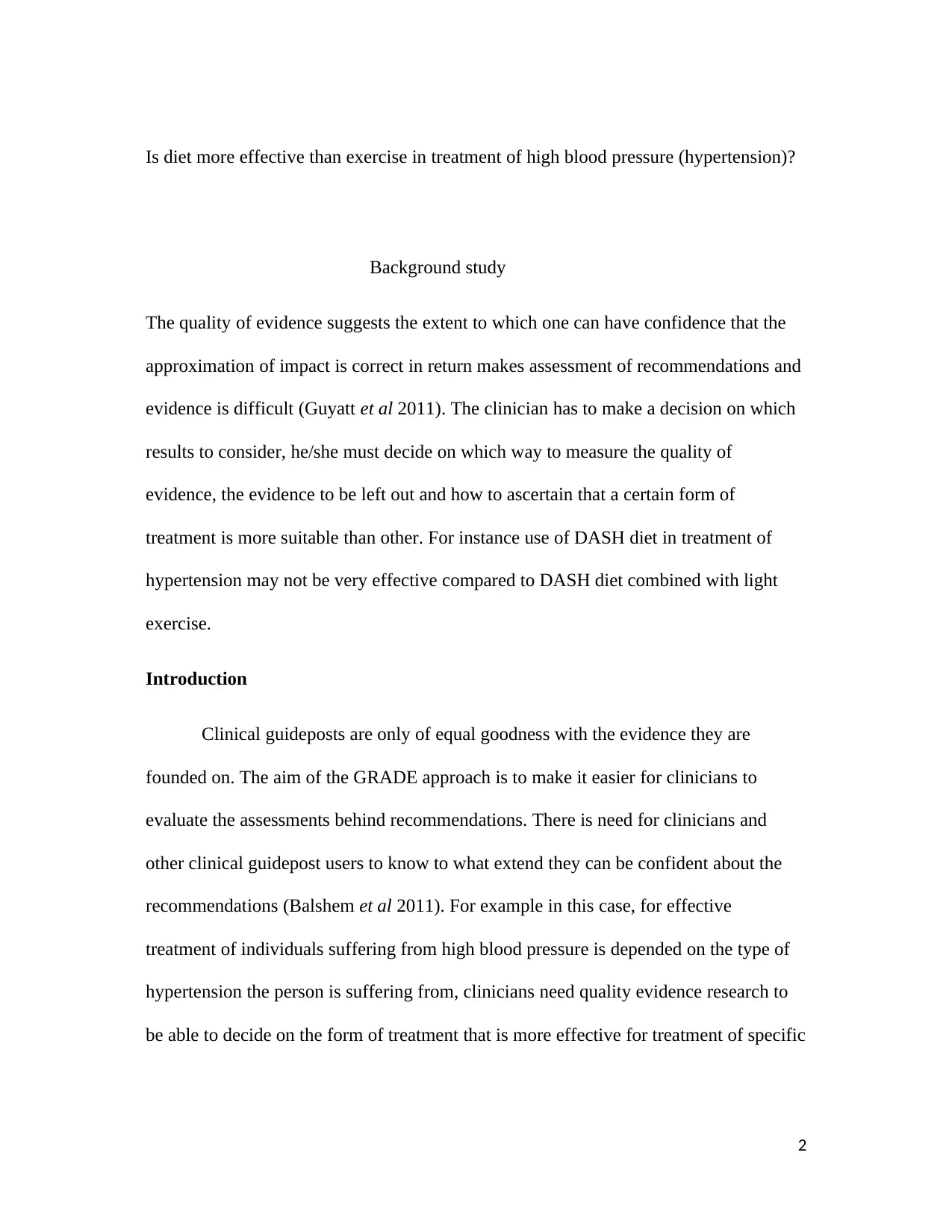
Is diet more effective than exercise in treatment of high blood pressure (hypertension)?
Background study
The quality of evidence suggests the extent to which one can have confidence that the
approximation of impact is correct in return makes assessment of recommendations and
evidence is difficult (Guyatt et al 2011). The clinician has to make a decision on which
results to consider, he/she must decide on which way to measure the quality of
evidence, the evidence to be left out and how to ascertain that a certain form of
treatment is more suitable than other. For instance use of DASH diet in treatment of
hypertension may not be very effective compared to DASH diet combined with light
exercise.
Introduction
Clinical guideposts are only of equal goodness with the evidence they are
founded on. The aim of the GRADE approach is to make it easier for clinicians to
evaluate the assessments behind recommendations. There is need for clinicians and
other clinical guidepost users to know to what extend they can be confident about the
recommendations (Balshem et al 2011). For example in this case, for effective
treatment of individuals suffering from high blood pressure is depended on the type of
hypertension the person is suffering from, clinicians need quality evidence research to
be able to decide on the form of treatment that is more effective for treatment of specific
2
Background study
The quality of evidence suggests the extent to which one can have confidence that the
approximation of impact is correct in return makes assessment of recommendations and
evidence is difficult (Guyatt et al 2011). The clinician has to make a decision on which
results to consider, he/she must decide on which way to measure the quality of
evidence, the evidence to be left out and how to ascertain that a certain form of
treatment is more suitable than other. For instance use of DASH diet in treatment of
hypertension may not be very effective compared to DASH diet combined with light
exercise.
Introduction
Clinical guideposts are only of equal goodness with the evidence they are
founded on. The aim of the GRADE approach is to make it easier for clinicians to
evaluate the assessments behind recommendations. There is need for clinicians and
other clinical guidepost users to know to what extend they can be confident about the
recommendations (Balshem et al 2011). For example in this case, for effective
treatment of individuals suffering from high blood pressure is depended on the type of
hypertension the person is suffering from, clinicians need quality evidence research to
be able to decide on the form of treatment that is more effective for treatment of specific
2

type of hypertension. For instance individuals with blood pressure of 130/80 mm/Hg
can manage the blood pressure by use of medicines such as angiotensin receptor
blockers, vasodilators and peripheral adrenergic blocker among others (Guyatt et al
2011)
Quality evidence search
High blood pressure also known as hypertension is a longstanding health
condition in which the blood pressure insistently raises. Over 85 million people across
the world suffer from high blood pressure while over 10million people die yearly due to
hypertension, (Polgar & Thomas 2013). The standard blood pressure is commonly 120
over 80mm of mercury. This condition is brought about by various factors such as
lifestyle and genetic disorders and risk factors such as age, sex, alcohol and tobacco use,
size and weight ethnicity and existing health conditions such diabetes, high cholesterol
and chronic kidney disease. Stress is a renowned cause of acute high blood pressure.
Medical conditions such as strokes and heart attack can come as a result of
untreated/unmanaged hypertension.
Blood pressure is best controlled through diet in advance, before it reaches the
stage of hypertension there are other treatment options lifestyle adjustment are the first-
line treatment for hypertension. Doctors highly recommend that patients with high
blood, pressure engage in at least 30 minutes of light exercises. These may include
jogging, cycling swimming or walking on at least five days a week. Some types of
hypertension can be controlled through lifestyle and dietetic adoptions (DASH diet)
3
can manage the blood pressure by use of medicines such as angiotensin receptor
blockers, vasodilators and peripheral adrenergic blocker among others (Guyatt et al
2011)
Quality evidence search
High blood pressure also known as hypertension is a longstanding health
condition in which the blood pressure insistently raises. Over 85 million people across
the world suffer from high blood pressure while over 10million people die yearly due to
hypertension, (Polgar & Thomas 2013). The standard blood pressure is commonly 120
over 80mm of mercury. This condition is brought about by various factors such as
lifestyle and genetic disorders and risk factors such as age, sex, alcohol and tobacco use,
size and weight ethnicity and existing health conditions such diabetes, high cholesterol
and chronic kidney disease. Stress is a renowned cause of acute high blood pressure.
Medical conditions such as strokes and heart attack can come as a result of
untreated/unmanaged hypertension.
Blood pressure is best controlled through diet in advance, before it reaches the
stage of hypertension there are other treatment options lifestyle adjustment are the first-
line treatment for hypertension. Doctors highly recommend that patients with high
blood, pressure engage in at least 30 minutes of light exercises. These may include
jogging, cycling swimming or walking on at least five days a week. Some types of
hypertension can be controlled through lifestyle and dietetic adoptions (DASH diet)
3
⊘ This is a preview!⊘
Do you want full access?
Subscribe today to unlock all pages.

Trusted by 1+ million students worldwide
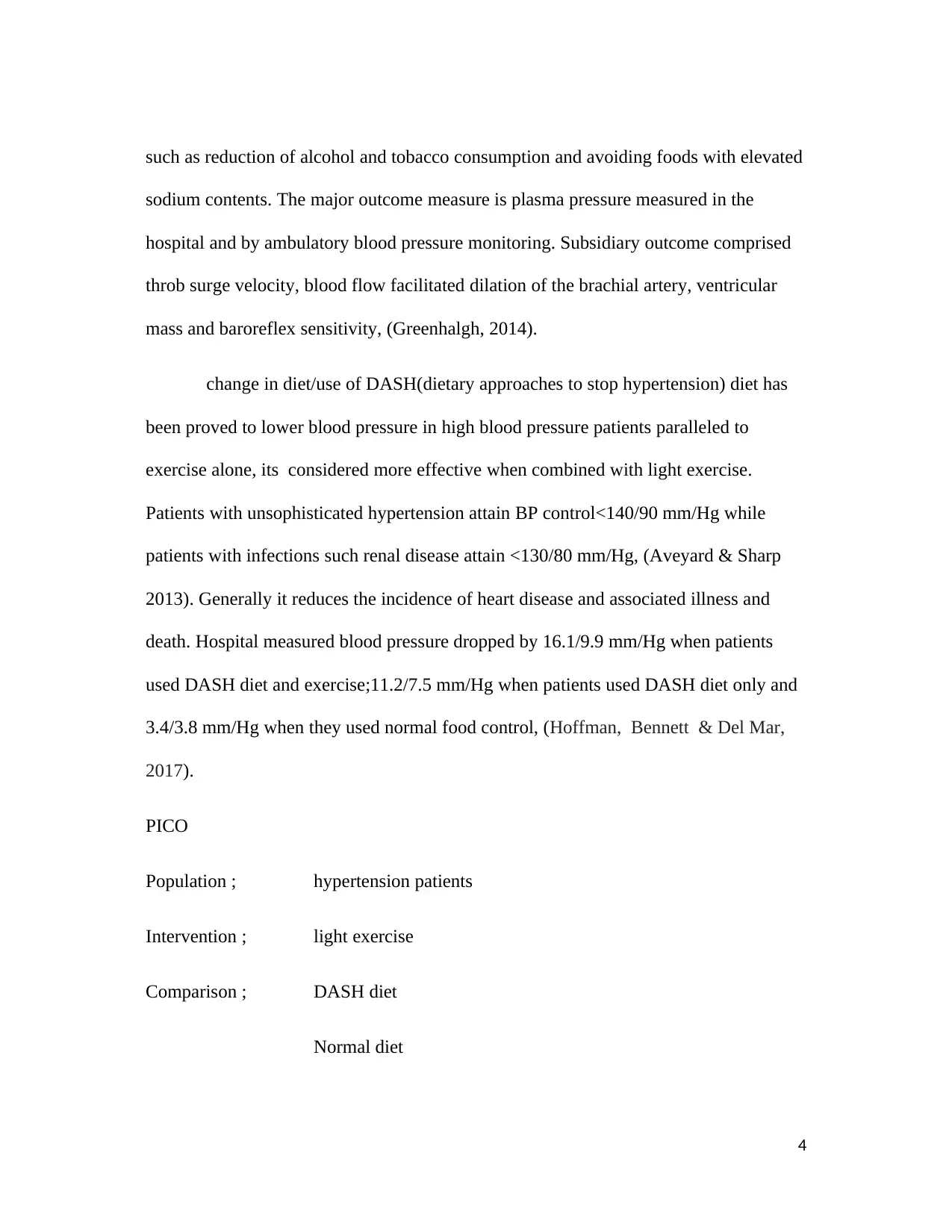
such as reduction of alcohol and tobacco consumption and avoiding foods with elevated
sodium contents. The major outcome measure is plasma pressure measured in the
hospital and by ambulatory blood pressure monitoring. Subsidiary outcome comprised
throb surge velocity, blood flow facilitated dilation of the brachial artery, ventricular
mass and baroreflex sensitivity, (Greenhalgh, 2014).
change in diet/use of DASH(dietary approaches to stop hypertension) diet has
been proved to lower blood pressure in high blood pressure patients paralleled to
exercise alone, its considered more effective when combined with light exercise.
Patients with unsophisticated hypertension attain BP control<140/90 mm/Hg while
patients with infections such renal disease attain <130/80 mm/Hg, (Aveyard & Sharp
2013). Generally it reduces the incidence of heart disease and associated illness and
death. Hospital measured blood pressure dropped by 16.1/9.9 mm/Hg when patients
used DASH diet and exercise;11.2/7.5 mm/Hg when patients used DASH diet only and
3.4/3.8 mm/Hg when they used normal food control, (Hoffman, Bennett & Del Mar,
2017).
PICO
Population ; hypertension patients
Intervention ; light exercise
Comparison ; DASH diet
Normal diet
4
sodium contents. The major outcome measure is plasma pressure measured in the
hospital and by ambulatory blood pressure monitoring. Subsidiary outcome comprised
throb surge velocity, blood flow facilitated dilation of the brachial artery, ventricular
mass and baroreflex sensitivity, (Greenhalgh, 2014).
change in diet/use of DASH(dietary approaches to stop hypertension) diet has
been proved to lower blood pressure in high blood pressure patients paralleled to
exercise alone, its considered more effective when combined with light exercise.
Patients with unsophisticated hypertension attain BP control<140/90 mm/Hg while
patients with infections such renal disease attain <130/80 mm/Hg, (Aveyard & Sharp
2013). Generally it reduces the incidence of heart disease and associated illness and
death. Hospital measured blood pressure dropped by 16.1/9.9 mm/Hg when patients
used DASH diet and exercise;11.2/7.5 mm/Hg when patients used DASH diet only and
3.4/3.8 mm/Hg when they used normal food control, (Hoffman, Bennett & Del Mar,
2017).
PICO
Population ; hypertension patients
Intervention ; light exercise
Comparison ; DASH diet
Normal diet
4
Paraphrase This Document
Need a fresh take? Get an instant paraphrase of this document with our AI Paraphraser
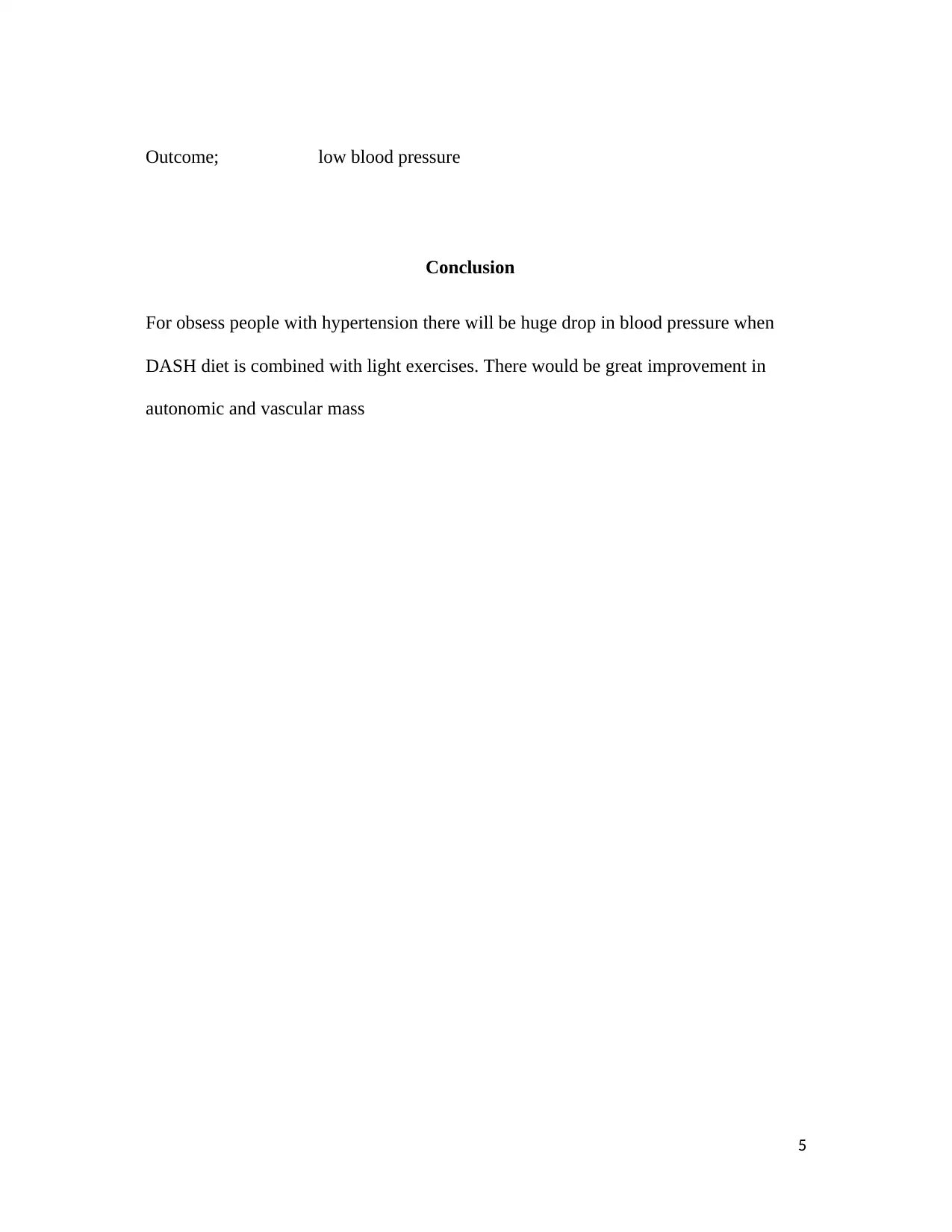
Outcome; low blood pressure
Conclusion
For obsess people with hypertension there will be huge drop in blood pressure when
DASH diet is combined with light exercises. There would be great improvement in
autonomic and vascular mass
5
Conclusion
For obsess people with hypertension there will be huge drop in blood pressure when
DASH diet is combined with light exercises. There would be great improvement in
autonomic and vascular mass
5
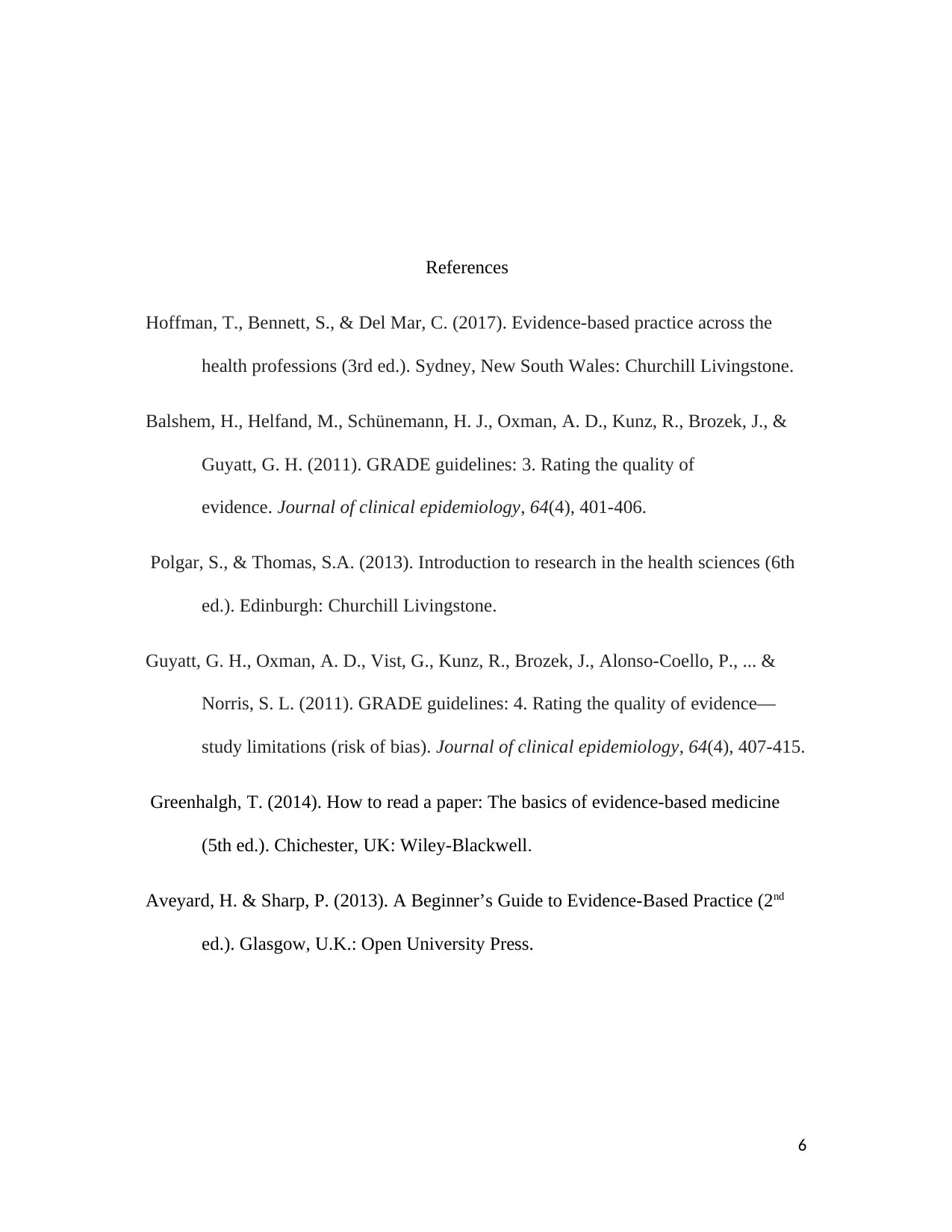
References
Hoffman, T., Bennett, S., & Del Mar, C. (2017). Evidence-based practice across the
health professions (3rd ed.). Sydney, New South Wales: Churchill Livingstone.
Balshem, H., Helfand, M., Schünemann, H. J., Oxman, A. D., Kunz, R., Brozek, J., &
Guyatt, G. H. (2011). GRADE guidelines: 3. Rating the quality of
evidence. Journal of clinical epidemiology, 64(4), 401-406.
Polgar, S., & Thomas, S.A. (2013). Introduction to research in the health sciences (6th
ed.). Edinburgh: Churchill Livingstone.
Guyatt, G. H., Oxman, A. D., Vist, G., Kunz, R., Brozek, J., Alonso-Coello, P., ... &
Norris, S. L. (2011). GRADE guidelines: 4. Rating the quality of evidence—
study limitations (risk of bias). Journal of clinical epidemiology, 64(4), 407-415.
Greenhalgh, T. (2014). How to read a paper: The basics of evidence-based medicine
(5th ed.). Chichester, UK: Wiley-Blackwell.
Aveyard, H. & Sharp, P. (2013). A Beginner’s Guide to Evidence-Based Practice (2nd
ed.). Glasgow, U.K.: Open University Press.
6
Hoffman, T., Bennett, S., & Del Mar, C. (2017). Evidence-based practice across the
health professions (3rd ed.). Sydney, New South Wales: Churchill Livingstone.
Balshem, H., Helfand, M., Schünemann, H. J., Oxman, A. D., Kunz, R., Brozek, J., &
Guyatt, G. H. (2011). GRADE guidelines: 3. Rating the quality of
evidence. Journal of clinical epidemiology, 64(4), 401-406.
Polgar, S., & Thomas, S.A. (2013). Introduction to research in the health sciences (6th
ed.). Edinburgh: Churchill Livingstone.
Guyatt, G. H., Oxman, A. D., Vist, G., Kunz, R., Brozek, J., Alonso-Coello, P., ... &
Norris, S. L. (2011). GRADE guidelines: 4. Rating the quality of evidence—
study limitations (risk of bias). Journal of clinical epidemiology, 64(4), 407-415.
Greenhalgh, T. (2014). How to read a paper: The basics of evidence-based medicine
(5th ed.). Chichester, UK: Wiley-Blackwell.
Aveyard, H. & Sharp, P. (2013). A Beginner’s Guide to Evidence-Based Practice (2nd
ed.). Glasgow, U.K.: Open University Press.
6
⊘ This is a preview!⊘
Do you want full access?
Subscribe today to unlock all pages.

Trusted by 1+ million students worldwide

7
1 out of 7
Related Documents
Your All-in-One AI-Powered Toolkit for Academic Success.
+13062052269
info@desklib.com
Available 24*7 on WhatsApp / Email
![[object Object]](/_next/static/media/star-bottom.7253800d.svg)
Unlock your academic potential
Copyright © 2020–2025 A2Z Services. All Rights Reserved. Developed and managed by ZUCOL.





